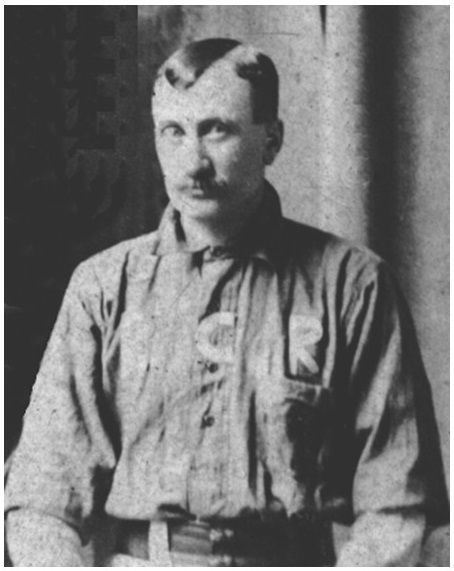Pre-First World War
Artifact PW1-04: Joseph Fleming
Reproduced by kind permission of Jim and Patti Keller (http://www.jgkeller.ca/Genealogy.html)

The Government did not want to send the Canadian Army through American territory at Skagway and over the Chilkoot Pass to Bennett Lake. Instead, the government wanted the Canadian Army to find an “all Canadian Route” up the Stikine River, from the boat terminal at Glenora, British Columbia. By the Treaty of Washington, in 1871, Canada had gained the right of free navigation on the Yukon, Porcupine and Stikine Rivers in exchange for American privileges on the St Lawrence River.
Their ship, “Islander” left Vancouver on May 14th, 1898 arriving at Wrangel on May 17th. From there they took small river boats up the Stikine River to the camp at Glenora, where they found 2500 stranded gold seekers. To reach Glenora the Field Force was forced to construct theirown boats from local trees. Having few nails they resorted to wood pins to assemble the boats. The boats were pulled up-river by ropes against the strong current. It took a further four months for the Force to get to the Klondike. It was an incredibly difficult journey with one diary entry describing making only one and one half miles through knee deep mud in one day.
Life in the Yukon Field Force was very difficult. Scurvy and frost-bite were common. Isolation was also a problem and “cabin fever” was not unheard of. The diary entry for Monday, March 27th 1899, mentions that a corporal with the N.W.M.P. had attempted suicide by cutting his own throat. It was later determined that scurvy had been a big factor and no charges were laid.
The Force built emergency shelters and N.W.M.P. Posts along the trail, and guarded gold shipments. Both the Field Force and the North West Mounted Police were very well respected by the miners. They were known to be fair but strict and crime was surprisingly low in the Klondike, especially considering 100 thousand miners were there, stuck mostly in tents under very difficult conditions. The biggest problems encountered by the police were known as “drunk and disorderly” or “obstructing the sidewalk”, (passed out).
In June, 1900, the Canadian Government decided there was no longer a need for the Field Force. The unit left Whitehorse, marched over the Chilkoot Pass to Skagway and sailed on the S. S. Columbian, reaching Vancouver on July 5th, 1900.
Joseph Fleming finally met his son, Herbert Stanley Fleming, who had been born 2½ years earlier. The visit was short though as he almost immediately joined the Canadian Forces headed to South Africa. On his World War One Attestation Papers, Joseph lists that he spent one year and 165 days in the South African Constabulary and had fought in the Boer War.
When he returned, he played on the Royal Canadian Regiment Cricket Team where his son, Stanley, was the bat boy.
When World War One broke out both Joseph and Stanley joined the Canadian Expeditionary Force.
Both survived and after the war, Joseph and his son lived near Haileybury, Ontario, in a small village known as Heaslip, when they were caught by the Great Haileybury Fire on October 04, 1922. Both died in the fire. Joseph Fleming was listed as Captain Henry Fleming in the newspaper list of deaths, just above his son, listed as Stanley Fleming.
